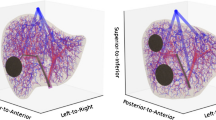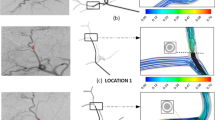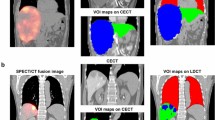Abstract
Yttrium-90 (Y-90) transarterial radioembolization uses radioactive microspheres injected into the hepatic artery to irradiate liver tumors internally. One of the major challenges is the lack of reliable dosimetry methods for dose prediction and dose verification. We present a patient-specific dosimetry approach for personalized treatment planning based on computational fluid dynamics (CFD) simulations of the microsphere transport combined with Y-90 physics modeling called CFDose. The ultimate goal is the development of a software to optimize the amount of activity and injection point for optimal tumor targeting. We present the proof-of-concept of a CFD dosimetry tool based on a patient’s angiogram performed in standard-of-care planning. The hepatic arterial tree of the patient was segmented from the cone-beam CT (CBCT) to predict the microsphere transport using multiscale CFD modeling. To calculate the dose distribution, the predicted microsphere distribution was convolved with a Y-90 dose point kernel. Vessels as small as 0.45 mm were segmented, the microsphere distribution between the liver segments using flow analysis was predicted, the volumetric microsphere and resulting dose distribution in the liver volume were computed. The patient was imaged with positron emission tomography (PET) 2 h after radioembolization to evaluate the Y-90 distribution. The dose distribution was found to be consistent with the Y-90 PET images. These results demonstrate the feasibility of developing a complete framework for personalized Y-90 microsphere simulation and dosimetry using patient-specific input parameters.








Similar content being viewed by others
References
Aramburu, J., R. Antón, A. Rivas, J. C. Ramos, G. S. Larraona, B. Sangro, and J. I. Bilbao. A methodology for numerically analysing the hepatic artery haemodynamics during b-TACE: a proof of concept. Comput. Methods Biomech. Biomed. Eng. 22:518–532, 2019.
Aramburu, J., R. Antón, A. Rivas, J. C. Ramos, B. Sangro, and J. I. Bilbao. The role of angled-tip microcatheter and microsphere injection velocity in liver radioembolization: a computational particle-hemodynamics study. Int. J. Numer. Method Biomed. Eng. 33:e2895, 2017.
Aramburu, J., R. Antón, A. Rivas, J. C. Ramos, B. Sangro, and J. I. Bilbao. Liver radioembolization: an analysis of parameters that influence the catheter-based particle-delivery via CFD. Curr. Med. Chem. 25:1–15, 2018.
Basciano, C. A., C. Kleinstreuer, A. S. Kennedy, W. A. Dezarn, and E. Childress. Computer modeling of controlled microsphere release and targeting in a representative hepatic artery system. Ann. Biomed. Eng. 38:1862–1879, 2010.
Braat, A. J. A. T., M. L. J. Smits, M. N. G. J. A. Braat, A. F. Van Den Hoven, J. F. Prince, H. W. A. M. De Jong, M. A. A. J. Van Den Bosch, and M. G. E. H. Lam. 90Y hepatic radioembolization: an update on current practice and recent developments. J. Nucl. Med. 56:1079–1087, 2015.
Celik, I. B., U. Ghia, P. J. Roache, and C. J. Freitas. Procedure for estimation and reporting of uncertainty due to discretization in CFD applications. J. Fluids Eng. 130:078001, 2008.
Cheneler, D., and M. Ward. Power output and efficiency of beta-emitting microspheres. Radiat. Phys. Chem. 106:204–212, 2015.
Couinaud, C. Le foie: Études anatomiques et chirurgicales. Paris: Masson, 1957.
Crookston, N. R., G. S. K. Fung, and E. C. Frey. Development of a customizable hepatic arterial tree and particle transport model for use in treatment planning. IEEE Trans. Rad. Plasma Med. Sci. 3:31–37, 2019.
Dieudonné, A., R. F. Hobbs, R. Lebtahi, F. Maurel, S. Baechler, R. L. Wahl, A. Boubaker, D. Le Guludec, G. Sgouros, and I. Gardin. Study of the impact of tissue density heterogeneities on 3-dimensional abdominal dosimetry: Comparison between dose kernel convolution and direct Monte Carlo methods. J. Nucl. Med. 54:236–243, 2013.
Elschot, M., J. F. W. Nijsen, A. J. Dam, and H. W. A. M. De Jong. Quantitative evaluation of scintillation camera imaging characteristics of isotopes used in liver radioembolization. PLoS ONE 6:e26174, 2011.
Elschot, M., B. J. Vermolen, M. G. Lam, B. De Keizer, M. A. Van Den Bosch, and H. W. De Jong. Quantitative comparison of PET and bremsstrahlung SPECT for imaging the in vivo yttrium-90 microsphere distribution after liver radioembolization. PLoS ONE 8:2, 2013.
Favelier, S., T. Germain, P. Y. Genson, J. P. Cercueil, A. Denys, D. Krause, and B. Guiu. Anatomy of liver arteries for interventional radiology. Diagn. Interv. Imaging 96:537–546, 2015.
Fowler, K. J., N. M. Maughan, R. Laforest, N. E. Saad, A. Sharma, J. Olsen, C. K. Speirs, and P. J. Parikh. PET/MRI of hepatic 90Y microsphere deposition determines individual tumor response. Cardiovasc. Interv. Radiol. 39:855–864, 2016.
Gulec, S. A., G. Mesoloras, and M. Stabin. Dosimetric techniques in 90Y-microsphere therapy of liver cancer: the MIRD equations for dose calculations. J. Nucl. Med. 47:1209–1211, 2006.
Ho, S., W. Y. Lau, W. T. Leung, M. Chan, K. W. Chan, P. J. Johnson, and A. K. C. Li. Arteriovenous shunts in patients with hepatic tumors. J. Nucl. Med. 38:1201–1205, 1997.
Ho, S., W. Y. Lau, T. W. Leung, M. Chan, Y. K. Ngar, P. J. Johnson, and A. K. Li. Partition model for estimating radiation doses from yttrium-90 microspheres in treating hepatic tumours. EJNMMI 23:947–952, 1996.
Högberg, J., M. Rizell, R. Hultborn, J. Svensson, O. Henrikson, J. Mölne, P. Gjertsson, and P. Bernhardt. Heterogeneity of microsphere distribution in resected liver and tumour tissue following selective intrahepatic radiotherapy. EJNMMI Res. 4:1–9, 2014.
Ilhan, H., A. Goritschan, P. Paprottka, T. F. Jakobs, W. P. Fendler, A. Todica, P. Bartenstein, M. Hacker, and A. R. Haug. Predictive value of 99mTc-MAA SPECT for 90Y-labeled resin microsphere distribution in radioembolization of primary and secondary hepatic tumors. J. Nucl. Med. 56:1654–1660, 2015.
Kennedy, A. S., C. Kleinstreuer, C. A. Basciano, and W. A. Dezarn. Computer modeling of yttrium-90-microsphere transport in the hepatic arterial tree to improve clinical outcomes. Int. J. Radiat. Oncol. Biol. Phys. 76:631–637, 2010.
Lam, M. G. E. H., J. D. Louie, M. H. K. Abdelmaksoud, G. A. Fisher, C. D. Cho-Phan, and D. Y. Sze. Limitations of body surface area–based activity calculation for radioembolization of hepatic metastases in colorectal cancer. J. Vasc. Interv. Radiol. 25:1085–1093, 2014.
Lorensen, W. E., and H. E. Cline. Marching cubes: a high resolution 3D surface construction algorithm. SIGGRAPH Comput. Graph. 21:163–169, 1987.
Martini, F., J. L. Nath, and E. F. Bartholomew. Fundamentals of Anatomy & Physiology. San Francisco: Pearson Benjamin Cummings, 2015.
Moghadam, K. M., A. Kamali Asl, P. Geramifar, and H. Zaidi. Evaluating the application of tissue-specific dose kernels instead of water dose kernels in internal dosimetry: a Monte Carlo study. Cancer Biother. Radiopharm. 31(3):67–379, 2016.
Pewowaruk, R., and A. Roldan-Alzate. 4D flow MRI estimation of boundary conditions for patient specific cardiovascular simulation. Ann. Biomed. Eng. 47:1786–1798, 2019.
Reneman, R. S., and A. P. Hoeks. Wall shear stress as measured in vivo: consequences for the design of the arterial system. Med. Biol. Eng. Comput. 46:499–507, 2008.
Rhee, S., S. Kim, J. Cho, J. Park, J. S. Eo, S. Park, E. Lee, Y. H. Kim, and J.-G. Choe. Semi-quantitative analysis of post-transarterial radioembolization 90Y microsphere positron emission tomography combined with computed tomography (PET/CT) images in advanced liver malignancy: comparison with 99mTc macroaggregated albumin (MAA) single photon emission computed tomography (SPECT). Nucl. Med. Mol. Imaging 50:63–69, 2016.
Riaz, A., R. J. Lewandowski, L. M. Kulik, M. F. Mulcahy, K. T. Sato, R. K. Ryu, R. A. Omary, and R. Salem. Complications following radioembolization with yttrium-90 microspheres: a comprehensive literature review. J. Vasc. Interv. Radiol. 20:1121–1130, 2009.
Ryde, H., P. Thieberger, and T. Alväger. Two-photon de-excitation of the 0 + level in Zr90. Phys. Rev. Lett. 6:475–478, 1961.
Salem, R., V. Mazzaferro, and B. Sangro. Yttrium 90 radioembolization for the treatment of hepatocellular carcinoma: biological lessons, current challenges and clinical perspectives. Hepatology 2013. https://doi.org/10.1002/hep.26382.
Sarrut, D., M. Bardiès, N. Boussion, N. Freud, S. Jan, J.-M. Létang, G. Loudos, L. Maigne, S. Marcatili, T. Mauxion, P. Papadimitroulas, Y. Perrot, U. Pietrzyk, C. Robert, D. R. Schaart, D. Visvikis, and I. Buvat. A review of the use and potential of the GATE Monte Carlo simulation code for radiation therapy and dosimetry applications. Med. Phys. 41:064301, 2014.
Silveira, L. A. D., F. B. C. Silveira, and V. P. S. Fazan. Arterial diameter of the celiac trunk and its branches: anatomical study. Acta Cir. Bras. 24:43–47, 2009.
Simoncini, C., K. Jurczuk, D. Reska, S. Esneault, J. C. Nunes, J. J. Bellanger, H. Saint-Jalmes, Y. Rolland, P. A. Eliat, J. Bezy-Wendling, and M. Kretowski. Towards a patient-specific hepatic arterial modeling for microspheres distribution optimization in SIRT protocol. Med. Biol. Eng. Comput. 56:515–529, 2018.
Stenvall, A., E. Larsson, S. E. Strand, and B. A. Jonsson. A small-scale anatomical dosimetry model of the liver. Phys. Med. Biol. 59:3353–3371, 2014.
Tiwari, A., S. Graves, and J. Sunderland. Measurements of dose point kernels using GATE Monte Carlo toolkit for personalized convolution dosimetry. J. Nucl. Med. 60:274, 2019.
Updegrove, A., N. M. Wilson, J. Merkow, H. Lan, A. L. Marsden, and S. C. Shadden. Simvascular: an open source pipeline for cardiovascular simulation. Ann. Biomed. Eng. 45:525–541, 2017.
Walrand, S., M. Hesse, C. Chiesa, R. Lhommel, and F. Jamar. The low hepatic toxicity per gray of 90Y glass microspheres is linked to their transport in the arterial tree favoring a nonuniform trapping as observed in posttherapy PET imaging. J. Nucl. Med. 55:135–140, 2014.
Wang, T., F. Liang, Z. Zhou, and X. Qi. Global sensitivity analysis of hepatic venous pressure gradient (HVPG) measurement with a stochastic computational model of the hepatic circulation. Comput. Biol. Med. 97:124–136, 2018.
Willowson, K., N. Forwood, B. W. Jakoby, A. M. Smith, and D. L. Bailey. Quantitative 90Y image reconstruction in PET. Med. Phys. 39:7153–7159, 2012.
Willowson, K. P., A. R. Hayes, D. L. H. Chan, M. Tapner, E. J. Bernard, R. Maher, N. Pavlakis, S. J. Clarke, and D. L. Bailey. Clinical and imaging-based prognostic factors in radioembolisation of liver metastases from colorectal cancer: A retrospective exploratory analysis. EJNMMI Res. 7:46, 2017.
Wondergem, M., M. L. J. Smits, M. Elschot, H. W. A. M. De Jong, H. M. Verkooijen, M. A. A. J. Van Den Bosch, J. F. W. Nijsen, and M. G. E. H. Lam. 99mTc-macroaggregated albumin poorly predicts the intrahepatic distribution of 90Y resin microspheres in hepatic radioembolization. J. Nucl. Med. 54:1294–1301, 2013.
Yzet, T., R. Bouzerar, J. D. Allart, F. Demuynck, C. Legallais, B. Robert, H. Deramond, M. E. Meyer, and O. Baledent. Hepatic vascular flow measurements by phase contrast MRI and Doppler echography: a comparative and reproducibility study. J. Magn. Reson. Imaging 31:579–588, 2010.
Acknowledgments
This work was funded by NIH R35 CA197608, CCSG P30 (NCI P30CA093373), UC Davis Academic Federation Innovation Development Award, and NIH R21 CA237686 (ITCR). The authors thank Dr Bahman S. Roudsari, Denise T. Caudle, Michael Rusnak, and Dr. Sara St. James for the angiogram interpretation, 90Y PET scans, and dose kernel computation.
Author information
Authors and Affiliations
Corresponding author
Additional information
Associate Editor Agata A. Exner oversaw the review of this article.
Publisher's Note
Springer Nature remains neutral with regard to jurisdictional claims in published maps and institutional affiliations.
Electronic supplementary material
Below is the link to the electronic supplementary material.
10439_2020_2469_MOESM1_ESM.eps
Figure S1. Hepatic artery segmentation pipeline. CBCT images with a resolution of 0.25 mm and slice thickness of 1 mm are segmented to extract blood vessels using a semi-automatic approach. Supplementary material 1 (EPS 634 kb).
10439_2020_2469_MOESM2_ESM.eps
Figure S2. 90Y dose kernel. (a) 90Y beta energy spectrum with a maximum energy of 2.28 MeV and peak at 860 keV. (b) Projection of the 1 mm dose point kernel computed with the 90Y spectrum shown in (a). (c) The energy deposited is highest close to the 90Y point source (located at 0 mm) and decreasing rapidly with increasing distance from the point source (note the log scale). Supplementary material 2 (EPS 140 kb).
10439_2020_2469_MOESM3_ESM.eps
Figure S3. Predicted dose distribution for the lobar and selective injections separately, which are shown combined in Fig. 7c. (a) Selective injection, coronal view, with a total dose of 58.3 Gy. (b) Lobar injection, coronal view, with a total of 67 Gy. Supplementary material 3 (EPS 59 kb).
Rights and permissions
About this article
Cite this article
Roncali, E., Taebi, A., Foster, C. et al. Personalized Dosimetry for Liver Cancer Y-90 Radioembolization Using Computational Fluid Dynamics and Monte Carlo Simulation. Ann Biomed Eng 48, 1499–1510 (2020). https://doi.org/10.1007/s10439-020-02469-1
Received:
Accepted:
Published:
Issue Date:
DOI: https://doi.org/10.1007/s10439-020-02469-1




